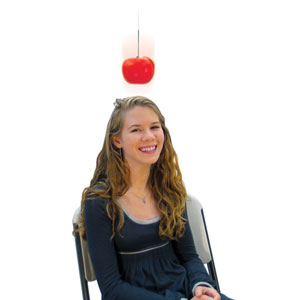Newton was a revolutionary thinker of his time. He is responsible for the three laws of motion that we still use today;
1. Objects that are not in motion remain stationary unless acted upon by another force.
2. There is a direct relationship between the force acted upon the object and the mass of that object times the acceleration the object feels (F=ma).
3. For every action there is an equal and opposite reaction.
 Nobody before Newton could explain why objects acted the way they did, but with these three laws he quantified movement in terms everyone could understand.
Nobody before Newton could explain why objects acted the way they did, but with these three laws he quantified movement in terms everyone could understand.
But there was a problem with his theory; if all motion had to be caused by some force acting on it, then why do objects fall towards the earth when you release them from a fixed position? This free falling object was in fact free, meaning free of outside forces acting upon it (besides wind resistance). There were no visible forces acting upon that object. So why do they move downward if nothing is acting on it? But Newton explained this motion with gravity. He said that gravity is a force that the earth has upon all objects, something invisible that pulls us down at all times at a constant acceleration. There is a myth that the way Newton thought of the idea of gravity was when he was thinking about it under an apple tree when an apple fell on Newton’s head and at that moment, he figured out that there must be a force pulling the object down. This is also why apples are used to demonstrate Newton’s force, but no one knows definitively if the myth is true or not.
At the time Newton didn’t know that the acceleration of Earth’s gravity would later be calculated at approximately 9.81 m/s2. Also, at the time, he couldn’t explain what this force was made of, but only that it was invincible and constant. It was many years later that Einstein explained gravity with the theory of relativity stating that space and time were really one thing called spacetime, that bound all objects together like a web such that when an object has mass, it stretches the spacetime causing objects around it to feel a ‘pull’ towards the center object. Also Einstein discovered that this force increases as the outer object gets closer to the center object. Think of it like a blanket being stretched really thin and a ball being placed in the center and another ball being rolled across the blanket from one side to the other. This would cause the one moving ball to move towards the ball in the center because of the bend in the blanket, or spacetime.
So, looking back at Newton and the apple, the earth’s mass causes a big bend in spacetime, which causes other objects, such as apples, to be pulled downward at all times, even when they are on the ground already. Hey, something has got to keep them from floating upward.
Now that we’ve explained the motion, let’s define it in equations so that we can predict how the object will act during a free falling motion. The first and most important thing to remember about free falling objects is that the mass doesn’t matter. A bowling ball and a pencil will fall, or accelerate at the same rate towards the earth. Meaning if you go on the roof of your building and drop a bowling ball and a pencil off of it at the same time, they will hit the earth at the same time. But someone might say, “What about a feather? It won’t fall at the same speed as a bowling ball.” And they would be right. But what they are forgetting is air resistance. The bowling ball has very little air resistance because it is very aerodynamic, but the feather is not very aerodynamic. If you were to repeat this test in a vacuum then the resistance due to air (drag) would be removed as a factor, and the objects would fall at the same speed and hit the ground at the same time.
So back to the equations; Using calculus, we can start with the equation for the acceleration of gravity and integrate an equation to define the velocity of the object and then integrate it again to find the position of the object. If we define x as time measured in seconds, then the equation for the acceleration of the object looks like this A(x) = 9.81. One might notice that there is no x in the actual equation and this is because no matter how long the object is falling, the acceleration of the object at any time will always be 9.81 m/s2. So by integrating that function of x, we get V(x) = 9.81x + C. In this case, we are defining the velocity of the object in a function of time. C represents any starting velocity of the object, such as if the object was thrown downward. This can also be defined as V0, or initial velocity. Then if we integrate that function again we get a position function that looks like this, S(x) = 4.905x2 + Cx + K. In this last equation, K represents an initial position, such as if you defined the height of the object being 10 meters above the starting point, then K = 10. And C still represents the initial velocity.
From these equations, we can know that, if we eliminate the wind resistance, any object, the free falls for 1 second will have an acceleration of 9.81 m/s2, a velocity of 9.81 m/s, and a position of 4.905 m. After 2 seconds it will have an acceleration of 9.81 m/s2, a velocity f 19.62 m/s, and a position of 19.62 m. And at 3 seconds, an acceleration of 9.81 m/s2, a velocity of 29.43 m/s, and a position of 44.145 m. You can predict all of these values at any time using these equations just by plugging in the number of seconds into x.
Keep in mind that all of these equations are generalizations of free falling objects. Certain objects, in real life, because of wind resistance, will fall at different rates. Also, due to wind resistance objects will reach something called terminal velocity where the velocity cannot go any higher because the wind speed it feels restricts any increase in velocity. For humans, the terminal velocity is typically around 54 m/s or about 120 mph. For a raindrop it is around 25 m/s. Also, the earth’s gravity, though seemingly constant, isn’t actually constant. It has very miniscule changes as you change locations on the earth’s surface due to the density of the Earth at that spot. But these changes are so small students shouldn’t even bother trying to account for them.
So, what is a Newton anyway? It is the force created by the weight of an average apple (mass of approximately 102g). Technically speaking, a Newton is the force required to accelerate a mass of 1 kilogram at a rate of 1 Meter per second per second. What better way for your students to visually understand Sir Isaac Newton’s idea of F=ma, than to drop a 1 Newton foam apple onto someone’s head? They will remember it forever! Educational Innovations sells Newton’s Apple as singles and in a six pack. The six pack includes a full Starter Guide, which includes experiments to conduct using the Newtown Apple, information about Sir Isaac Newton, and information about the Newton as a unit.
Experiments For Your Students using Newton’s Apple:
Elementary/ Middle School Students
1. Have students hold their hand straight out. Ask them to describe what they feel on their hand. Then place the Newton’s Apple on their hand. Ask them to describe what they feel on their hand now. Ask them what they think will happen if another apple is added to their hand. Ask them to explain why this is the case.
2. Take a Newton’s Apple and a pencil or another small object and weight each object so the students can see the difference in weights. Ask them to predict what would happen if you dropped the objects from the same height at the same time (i.e. which would hit the ground first?). Have a student release the objects at the same time from the same height. Ask the students to describe what happens. Try to relay the concept that the mass of the objects didn’t really matter because no matter what they weigh, the objects will still fall at the same speed and hit the ground at the same time.
3. Repeat the same experiment as before but use something with a lot of air resistance, such as a piece of paper. Then crumble the paper up into a ball and drop both objects again. This time explain to the students that because the paper had a lot of air resistance before, it took longer, but then when it was made in a ball, the paper was still the same weight but now less air resistant.
High School Students
1. Take a block of wood and tie it to a piece of string. Then tie the other end of the string to the Newton’s Apple. Put the block of wood on a table and then hang the Newton’s Apple over the edge. Make the table surface smooth enough that the block will slide, but not too fast. This experiment is to demonstrate friction between two surfaces and how it would affect the almost free falling object. Place the block on a table with a different surface (one that is less smooth). Notice the difference.
2. Attach a spring to a pole or hanger such that the spring can dangle freely. Then attach the Newton’s Apple to the other end of the spring. Pull down the Newton’s Apple so that when you release the Newton’s Apple it will move up and down in a continuous pendulum-like motion. Ask the students to describe the motion and to predict what would happen if you double the weight at the end of the spring. Add a second Newton’s Apple to the end of the spring and repeat the motion of the spring by pulling down the Newton’s Apples the same distance as before.

